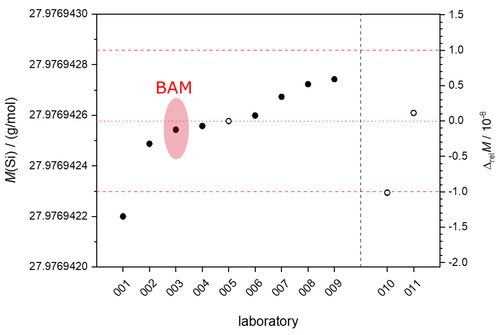
Single crystal of 28Si-enriched silicon used for the realization of the SI base units kilogram and mole
Source: PTB / Creative Commons CC-BY 4.0
In 2018, the General Conference on Weights and Measures (CGPM) agreed on the revision of the International System of units (SI). After its implementation in 2019, the seven base units are defined via fundamental constants, with the major change being the new definition of the kilogram (kg). The base unit of the mass was previously defined via a single artefact, the kilogram prototype, and is now defined via the Planck constant. The most suitable methods for the realization of the kilogram are the Kibble balance and the X-Ray crystal density method (XRCD). While the Kibble balance directly determines the Planck constant via a comparison of mechanical and electrical power, the XRCD method counts the silicon atoms in a silicon sphere, thus yielding the Avogadro constant NA. After the revision of the SI, the value of Avogadro constant NA is fixed to 6.022 140 76 × 1023 mol–1. With this definition, the XRCD method can be applied to determine the mass or the amount of substance of a silicon sphere. Besides the volume of the silicon sphere and the lattice parameter of a silicon unit cell, the molar mass of silicon is the most crucial parameter for determining the mass. The prerequisite for revising the definition of the mass was to undercut a relative uncertainty of 0.000002 % for all parameters and thus as well for the molar mass of silicon in a 28Si-enriched silicon sphere. To test for the required measurement capability and to demonstrate worldwide comparability, the Consultative Committee for Amount of Substance (CCQM) organized a pilot study on this topic, which was piloted by PTB.

Figure 1: Result for the molar mass M(Si) of 28Si-enriched silicon as obtained in the pilot study CCQM-P160 as reported by the individual participants. The red ellipse marks the value obtained by BAM by applying multi collector inductively coupled plasma mass spectrometry.
Source: BAM
The results obtained all by inductively coupled plasma mass spectrometry are depicted in figure 1 demonstrating uncertainty values of ≈ 0.0000001 % for the individual values as reported by the participating National Metrology Institutes and Designated Institutes as well as an overall agreement of better than 0.000001 %. With this result comparability and compatibility of the molar mass of silicon in a 28Si-enriched silicon sphere at an uncertainty level of better than 0.000002 % could be established.
The comparability of the determination of the molar mass of silicon highly enriched in 28Si: results of the CCQM-P160 interlaboratory comparison and additional external measurements
Olaf Rienitz, Axel Pramann, Jochen Vogl, Kyoung-Seok Lee, Yong-Hyeon Yim et.al.
published in Metrologia, Vol. 57, page 065028, 2020


